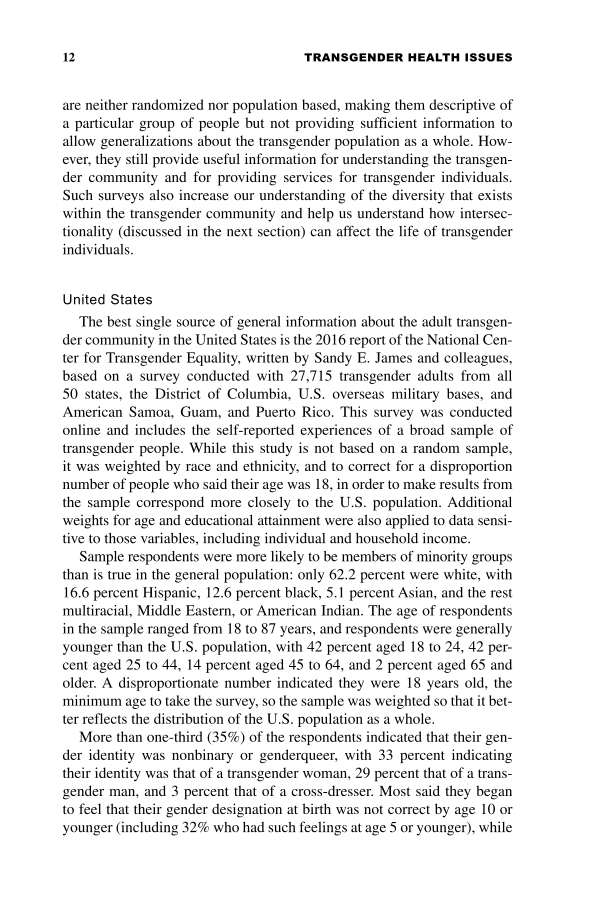12 TRANSGENDER HEALTH ISSUES are neither randomized nor population based, making them descriptive of a particular group of people but not providing sufficient information to allow generalizations about the transgender population as a whole. How- ever, they still provide useful information for understanding the transgen- der community and for providing services for transgender individuals. Such surveys also increase our understanding of the diversity that exists within the transgender community and help us understand how intersec- tionality (discussed in the next section) can affect the life of transgender individuals. United States The best single source of general information about the adult transgen- der community in the United States is the 2016 report of the National Cen- ter for Transgender Equality, written by Sandy E. James and colleagues, based on a survey conducted with 27,715 transgender adults from all 50 states, the District of Columbia, U.S. overseas military bases, and American Samoa, Guam, and Puerto Rico. This survey was conducted online and includes the self-reported experiences of a broad sample of transgender people. While this study is not based on a random sample, it was weighted by race and ethnicity, and to correct for a disproportion number of people who said their age was 18, in order to make results from the sample correspond more closely to the U.S. population. Additional weights for age and educational attainment were also applied to data sensi- tive to those variables, including individual and household income. Sample respondents were more likely to be members of minority groups than is true in the general population: only 62.2 percent were white, with 16.6 percent Hispanic, 12.6 percent black, 5.1 percent Asian, and the rest multiracial, Middle Eastern, or American Indian. The age of respondents in the sample ranged from 18 to 87 years, and respondents were generally younger than the U.S. population, with 42 percent aged 18 to 24, 42 per- cent aged 25 to 44, 14 percent aged 45 to 64, and 2 percent aged 65 and older. A disproportionate number indicated they were 18 years old, the minimum age to take the survey, so the sample was weighted so that it bet- ter reflects the distribution of the U.S. population as a whole. More than one-third (35%) of the respondents indicated that their gen- der identity was nonbinary or genderqueer, with 33 percent indicating their identity was that of a transgender woman, 29 percent that of a trans- gender man, and 3 percent that of a cross-dresser. Most said they began to feel that their gender designation at birth was not correct by age 10 or younger (including 32% who had such feelings at age 5 or younger), while
Document Details My Account Print multiple pages
Print
You have printed 0 times in the last 24 hours.
Your print count will reset on at .
You may print 0 more time(s) before then.
You may print a maximum of 0 pages at a time.
























































































































































































































